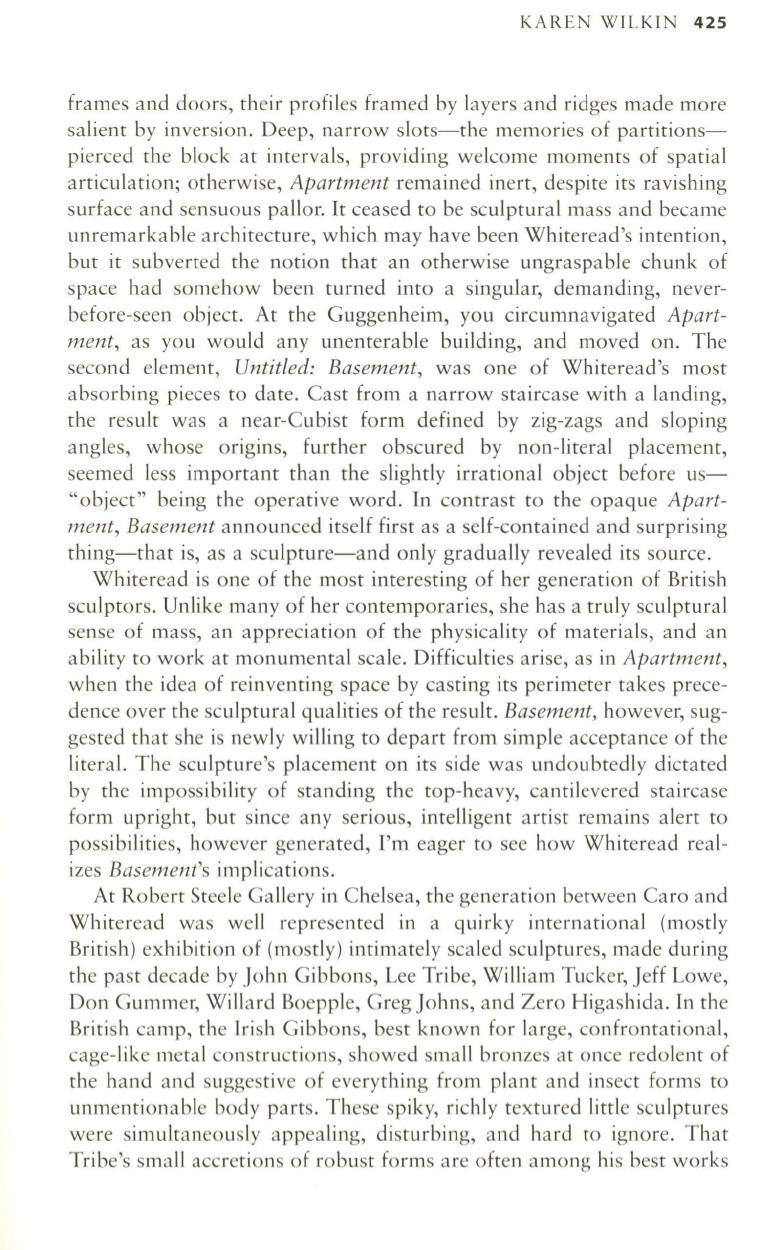
KAREN WILKIN
425
frames and doors, their profiles framed by layers and ridges made more
salient by inversion. Deep, narrow slots-the memories of partitions–
pierced the block at intervals, providing welcome moments of spatial
articulation; otherwise,
Apartment
remained inert, despite its ravishing
surface and sensuous pallor. It ceased to be sculptural mass and became
unremarkable architecture, which may have been Whiteread's intention,
but it subverted the notion that an otherwise ungraspable chunk of
space had somehow been turned into a singular, demanding, never–
before-seen object. At the Guggenheim, you circumnavigated
Apart–
ment,
as you would any unenterable building, and moved on. The
second element,
Untitled: Basement,
was one of Whiteread's most
absorbing pieces to date. Cast from a narrow staircase with a landing,
the result was a near-Cubist form defined by zig-zags and sloping
angles, whose origins, further obscured by non-literal placement,
seemed less important than the slightly irrational object before us–
"object" being the operative word . In contrast to the opaque
Apart–
ment, Basement
announced itself first as a self-contained and surprising
thing-that is, as a sculpture-and only gradually revealed its source.
Whiteread is one of the most interesting of her generation of British
sculptors. Unlike many of her contemporaries, she has a truly sculptural
sense of mass, an appreciation of the physicality of materials, and an
ability to work at monumental scale. Difficulties arise, as in
Apartment,
when the idea of reinventing space by casting its perimeter takes prece–
dence over the sculptural qualities of the result.
Basement,
however, sug–
gested that she is newly willing to depart from simple acceptance of the
literal. The sculpture's placement on its side was undoubtedly dictated
by the impossibility of standing the top-heavy, cantilevered staircase
form upright, but since any serious, intelligent artist remains alert to
possibilities, however generated, I'm eager to see how Whiteread real–
izes
Basement's
implications.
At Robert Steele Gallery in Chelsea, the generation between Caro and
Whiteread was well represented in a quirky international (mostly
British) exhibition of (mostly) intimately scaled sculptures, made during
the past decade by John Gibbons, Lee Tribe, William Tucker, Jeff Lowe,
Don Gummer, Willard Boepple, Greg Johns, and Zero Higashida. In the
British camp, the Irish Gibbons, best known for large, confrontational,
cage-like metal constructions, showed small bronzes at once redolent of
the hand and suggestive of everything from plant and insect forms
to
unmentionable body parts. These spiky, richly textured little sculptures
were simultaneously appealing, disturbing, and hard to ignore. That
Tribe's small accretions of robust forms are often among his best works


